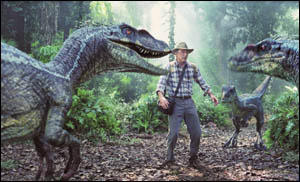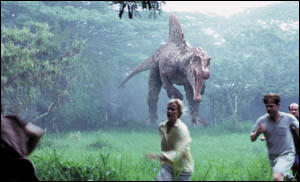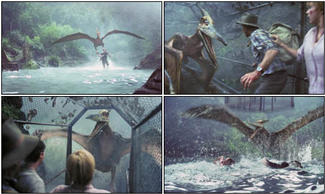|
Raptor Redux
|
| ILM revitalizes the raptors, T rexes, and other digital dinos in
Jurassic Park III |
By Barbara Robertson |
© 2001 Universal Pictures. Photo credit
ILM. |
When the crew at Industrial Light & Magic (San Rafael, CA) was
asked to recreate the dinosaurs from Jurassic Park for the third time,
they did what any effects crew would try to do: produce something more
incredible than last time . . . or the time before. |
When the crew at Industrial Light & Magic (San Rafael, CA) was
asked to recreate the dinosaurs from Jurassic Park for the third time,
they did what any effects crew would try to do: produce something more
incredible than last time . . . or the time before.
|

In the Universal Pictures film, directed by Joe Johnston and released
July 18, moviegoers once again watch prehistoric dinosaurs terrorize a
few intrepid visitors to Isla Sorna, the original Jurassic Park location.
To help enliven the sequel, ILM developed new techniques for the visual
effects in two main areas: The team created a simulator that moves the
digital dinosaurs' skin across muscles and bones in a realistic manner,
and they made breakthroughs in integrating the dinosaurs with the environment.
|
"It's not enough just to do the dinosaurs," says Mitchell. "Now the
big thing is what you do to make the dinosaurs part of the scene."
|
Physically Fit
|
To help the dinosaurs look like they be longed in the environment,
the effects team focused on two issues: matching the CG dinosaurs to the
animatronics, and creating photorealistic natural elements-including, for
one dramatic sequence, an entirely CG world.
|
Unlike the earlier movies in which the camera would cut from animatronic
to CG dinosaurs, in Jurassic Park III, both types of dinosaurs appear in
the same scenes, sometimes nose to nose. For example, during a fight between
a spinosaurus and a T rex, sometimes the T rex is CG, sometimes animatronic;
sometimes the spino is CG and sometimes animatronic. It's im possible to
tell which is what, even in close-ups. In another scene, CG and animatronic
raptors surround actor Sam Neill. "It's amazing to be on the ground, right
in front of a 12-ton creature and see it power up," says Mitchell of the
animatronic. "It puts you into the moment."
|

To create CG dinos that looked as real, ILM's painters used photographs
of the animatronics as reference for painted texture maps, and created
displacement maps so the renderer would carve surface geometry into a lizard-like
texture.
|
The effects team got a surprise, though, when they looked at the first
live-action plates. In reference photos, the animatronics were brownish,
but lights on the set had given them a bluish cast. Moreover, colored filters
had created patterns in hues of green, orange, and blue that slid across
the animatronics' skin as they moved in the live-action plates, to give
the impression of a canopy of jungle foliage. "We had to match the same
color space," says Samir Hoon, sequence supervisor. "So, we ended up using
ambient occlusion."
|
This rendering technique, developed at ILM for Pearl Harbor (see "War
Effort," June 2001, pg. 22) to simulate diffuse light in an environment,
added colors from the plate to the rendering of the dinosaurs' skin. To
make ambient occlusion useful for Jurassic Park III, the team had to extend
the technique so that it worked with deformable, animated creatures and
would handle motion blur and displacement-effects not needed in Pearl Harbor.
The ambient occlusion technique worked so well it was used for all the
sequences. Sometimes, ambient occlusion and reflection maps provided all
the light needed for a scene.
|
For example, in one scene the wet body of a spino walking through a
lake reflects a fire burning in the foreground. "We would run the reflection
map and the ambient map on every frame from the plate and get the flickering
lights and flames on the spino automatically," says Christophe Hery, CG
supervisor. "It was a major breakthrough."
|
"The ambient technique is not the only technique you want to use, but
it's a great help," he adds. "It freed the technical directors so they
could focus on adding key lights and secondary lights to make the creatures
look beautiful instead of spending time placing fill lights." All the CG
creatures and scenes in Jurassic Park III were rendered through Pixar Animation
Studio's Render Man, with Mental Images' Mental Ray helping with the ambient
occlusion.
|
Plant Happy
|
Fitting the dinosaurs into the environment also meant helping the beasts
look as if they were interacting with the environment. When a dinosaur
crashes through the forest, it moves trees and plants aside, tramples grass
underfoot and splashes water when its big foot steps in a puddle. In the
first Jurassic Park films, people on location or on the set moved trees
and plants with rigs, and painters removed the rigs from the plates later.
Thus, animators had to position their digital dinosaurs so that it looked
like the animals were interacting with the trees and plants in the plate.
This time, though, the animators created the performances they wanted and
the technical team fixed the plate to match.
|

In the sequence with the two dinosaurs fighting, for example, dozens
of CG elements added after the dinosaurs were animated helped make the
live-action environment livelier. The effects team put a puddle under a
dino's foot, added little animals that scurried away from the frightening
beasts, showered the thrashing dinos with falling leaves, and added plants.
"We've reached a point where the plate is almost secondary to us," says
Hery.
|
Throughout the film, the dinosaurs brush aside vines that exist only
in the computer and move plants that are half digital and half real. "We
were really plant happy in this movie," says Hoon. In one shot, for example,
all the ferns in the live-action plate were replaced with CG ferns so the
plants would move automatically when a CG raptor ran through them.
|
To create plants, the team used Alias|Wavefront's Maya Paint Effects
running on SGI workstations. "Paint Effects doesn't motion blur properly,
so we had to come up with solutions for that," Hery says. "But it's quick.
You just draw brush strokes and grow leaves out of that."
|
Rather than use the dynamic engine in Paint Effects to animate plants,
the team developed a separate system based on particle dynamics "When any
part of the raptor touched a plant, it would respond correctly," Hoon says.
Rather than use the dynamic engine in Paint Effects to animate plants,
the team developed a separate system based on particle dynamics "When any
part of the raptor touched a plant, it would respond correctly," Hoon says.
|
Here's how it worked: First, they drew a plant in Paint Effects and
separately, a curve (a spline) the same height and then attached the two.
Next, they converted the spline into a soft body, turning each point on
the spline into a particle so that it would respond to collisions using
typical particle dynamics. Thus, when a particle collided with a piece
of geometry, it moved; and when a particle moved, the Paint Effects plant
followed.
|
| To render the plants, the team borrowed an idea from ILM's crowd pipeline.
"We created libraries with instanced geometry for vines and leaves. Instead
of instancing cycles of animated creatures, we instanced cycles of moving
leaves," Hery says. |
| Grand Canyon |
If it's possible to create plants photorealistic enough to live alongside
plants filmed on location, why not create an entirely synthetic location?
For much of the so-called aviary sequence, the team did exactly that. "I'm
partial to this sequence because it's so fast paced," says Mitchell. "You're
flying alongside pteranodons."
|
The 15-minute sequence takes place in a 100-acre, fog-enshrouded canyon
with steep, craggy, 300-foot walls, down which waterfalls cascade into
a rapidly flowing river. It's the pteranodons' aviary and nesting ground,
and much of the 15-minute sequence was created entirely with computer graphics.
|
At one point during the sequence, a pteranodon walks out of the fog,
plucks the child, Eric (actor Trevor Morgan), off a bridge across the canyon,
and flies with him dangling from its talons to a nest of hungry fledgling
pteranodons.
|
he actor was filmed on a bluescreen stage hanging from bird-like legs,
which were moved on a rig. To give animators freedom to move the bluescreen
boy in 3D space, the effects team attached a "card," (a polygon), to the
CG pteranodon's feet. Then they mapped the bluescreen character onto the
card. The rest of the environment was created with Avid's Soft Image 3D
models and RenderMan shaders.
|
The shaders do most of the work. In fact, a view of the undressed geometry
looks like a bad virtual reality scene. The nest sits on tall, garishly
colored cylinders, the walls look like flat planes, the boy in an egg-shaped
slice of bluescreen hovers above the animatronic nestlings, and it's hard
to believe this will become a photorealistic landscape.
|
The shader, masterminded by technical director Toan-Vinh Lee, turned
the canyon walls into rocks, created waterfalls and a river below, and
grew ferns and foliage on the walls. Fractal-based displacement created
the crevices and rock formations. Plants were grown in the walls based
on proximity fields. "You paint a map that pinpoints where you want the
plants to be grown," says Robert Weaver, sequence supervisor. Specular
noise created the waterfall and a canopy with a grid pattern was formed
from simple patches, all in RenderMan.
|

To create a dense fog that matched what the fog machine generated on
stage, Hery opted to work with spheres in Soft Image to position the fog
in 3D space. He then rendered the spheres with simple RenderMan shaders
that used fractal noise-a faster process than if he'd used particle or
volume simulation.
|
In addition to the foggy canyon, the sequence also had CG water created
with a combination of a fractal-based shader and particle mist, a completely
computer generated parasail, a sort of parachute-like flying ma chine developed
by technical director Nigel Sumner, and many flying CG pteranodons.
|
Skin Care
|
The film, of course, had a host of other prehistoric digital animals
ranging in size from two-feet to 51-feet tall, all modeled in Alias|Wavefront's
Power Animator and ILM's ISculpt. In addition to velociraptors, spinosauruses,
T rexes and pteranodons, the film also starred CG brachiosauruses, ankylosauruses,
compsognathuses, parasaurolophuses, corythosauruses, stegosauruses, triceratops,
and ceratsauruses.
|
Making all these dinosaurs move realistically took the efforts of the
animation team, led by Dan Taylor, but the skin simulations created by
the technical teams helped. Sebastian Marino, CG software developer, based
the new skin simulation techniques on volumetric simulations developed
by John Anderson, CG scientist, that were first used for The Mummy.
|
"Basically what we simulate is the volume of the skin and essentially
the fat layer of the creature," says Marino. A three-dimensional point
mesh, in which any vertex could connect to any number of other vertices,
created the simulation.
|
This "flesh mesh" has the characteristics of foam and Jell-O. Like
foam, when one end of the mesh is squeezed, it compresses but the other
end doesn't get larger, and when the pressure is released, the mesh returns
to its original shape. And like Jell-O, it jiggles.
|
To create the simulation, a dinosaur's volumes-its torso, arms, legs,
and tail-were filled with the mesh, and the mesh was linked to the creature's
primary motion. "It's as if the mesh is attached to a centerline down the
volumes of the creatures," says Tim McLaughlin, creature supervisor. "As
the critter moves, the mesh goes along for the ride."
|
The amount the mesh moved and jiggled during that ride depended on
various stiffness and damping parameters and on whether there were obstacles
such as muscles or bones in its path. The mesh contoured over muscles and
bones that pushed it from one place to another as they moved-imagine punching
a foam pillow. Also, waves of motion propagated through the mesh-imagine
shaking a bowl of Jell-O.
|

Thus, the simulator caused the belly of the T rex to shake like Jell-O;
and, at the other end of the spectrum, caused muscles to ripple under the
skin of the raptors' athletic bodies. "As the mesh gets pushed from one
place to another, you can see what's driving a creature, which is something
you never get with enveloping," Marino says. "First, you see muscles flexing,
and then the leg goes forward and extends. As the creature steps down,
you see the muscles tighten up and see that movement affecting the fat
layer."
|
The skin sims were not used for every shot-motion blur and camera shake,
for example, would often hide the effect. When they were used, however,
the team discovered the simulator had a positive effect on textures: It
prevented texture stretching. Because it stretched the skin globally rather
than locally, the skin moved more naturally. "The simulations didn't alter
the way the models were painted, but the textures looked better when the
dinosaurs moved," says McLaughlin.
|
All told, ILM created 406 shots for the film, nearly eight times the
55 visual effects shots created by the studio for the first Jurassic Park.
That movie convinced Hollywood that movies with computer graphics creatures
could be both cost-effective and box-office hits. "We were breaking ground
then, putting detail into reptilian skin textures, creating realistic animation,
faking how skin reacts to the way bones move," says Mitchell, who was a
technical director for the original Jurassic Park.
|
| Eight years later they've done it again. ILM improved on the original
breakthroughs and pushed the state of the art further with the skin simulations
and by intermingling CG dinosaurs with animatronics. Moreover, while the
first Jurassic Park demonstrated that CG dinosaurs made production sense,
this one shows that totally synthetic natural environments do, too. "You
can always make an environment that's stylized," says Weaver. "But if you're
trying to sell it as photoreal, you've entered a new ball game. To be able
to do that within a budget that's feasible from a production standpoint
is really important."
|
Barbara Robertson is Senior Editor, West Coast for Computer
Graphics World.
|
Computer Graphics World August, 2001
Author(s) : Barbara Robertson |
|